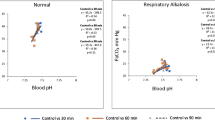Abstract
Acetazolamide, which reversibly inhibits carbonic anhydrase, is a useful diuretic in alkalotic and over-hydrated patients. In two earlier investigations we have consistently found increases in the arterial and venous oxygen saturation and tension when patients were treated with acetazolamide 15 mg·kg-1. A plausible explanation of this phenomenon is that acetazolamide diminishes oxygen consumption. In the present study we measured oxygen uptake in 10 critically ill patients. We found a minor and statistically insignificant decrease in oxygen consumption. Nevertheless SvO2 increased from 0.77 to 0.83 and PvO2 from 5.9 kPa to 6.8 kPa. It is still not possible from this investigation to determine the origin of the improvement in blood oxygenation. The inhibition of carbonic anhydrase caused a CO2 retention of 5.8% of the total CO2 production. An increase in body stores of CO2 of this magnitude is without clinical significance.
Similar content being viewed by others
References
Khan MI (1980) Treatment of refractory congestive heart failure and normokalemic hypochloremic alkalosis with acetazolamide and spironolactone. CMA Journal 123:883
Gallagher TJ (1979) Metabolic alkalosis complicating weaning from mechanical ventilation. South Med J 72:786
Jarboe TM, Penman RW, Luke RG (1972) Ventilatory failure due to metabolic alkalosis. Chest (Suppl) 61:61
Berthelsen P (1982) Cardiovascular performance and oxyhemoglobin dissociation after acetazolamide in metabolic alkalosis. Intensive Care Med 8:269
Krintel JJ, Haxholdt OSt, Berthelsen P, Brøckner J (1983) Carbon dioxide elimination after acetazolamide in patients with chronic obstructive pulmonary disease and metabolic alkalosis. Acta Anaesthiol Scand 27:252
Norlander O (1982) New concepts of ventilation. Acta Anaesthiol Belg 23:221
Laux BE, Raichle ME (1978) The effect of acetazolamide on cerebral blood flow and oxygen utilization in the rhesus monkey. J Clin Invest 62:585
Cotev S, Lee J, Severinghaus JW (1968) The effects of acetazolamide on cerebral blood flow and cerebral tissue \({\text{P}}_{{\text{O}}_{\text{2}} } \). Anesthesiology 29:471
Bradwell AR, Burnett D, Davies F et al (1981) Acetazolamide in control of acute mountain sickness. Lancet 1:180
Harken AH (1976) Hydrogen ion concentration and oxygen uptake in an isolated canine hindlimb. J Appl Physiol 40:1
Bidani A, Crandall ED (1978) Slow postcapillary changes in blood pH in vivo: titration with acetazolamide. J Appl Physiol 45:565
Cao TP, Rous S (1978) Action of acetazolamide on liver pyruvate carboxylase activity, glycogenolysis and gluconeogenesis of mice. Int J Biochem 9:603
Cao TP, Rous S (1978) Inhibitory effect of acetazolamide on the activity of acetyl CoA carboxylase of mouse liver. Life Sci 22:2067
Evans OB, Kilroy AW, Fenichel GM (1978) Acetazolamie in the treatment of pyruvate dysmetabolism syndromes. Arch Neurol 35:302
Askanazi J, Nordenstrom J, Rosenbaum SH et al. (1981) Nutrition for the patient with respiratory failure. Anesthesiology 54:373
Author information
Authors and Affiliations
Rights and permissions
About this article
Cite this article
Berthelsen, P., Gøthgen, I., Husum, B. et al. Oxygen uptake and carbon dioxide elimination after acetazolamide in the critically ill. Intensive Care Med 11, 26–29 (1985). https://doi.org/10.1007/BF00256061
Accepted:
Issue Date:
DOI: https://doi.org/10.1007/BF00256061




